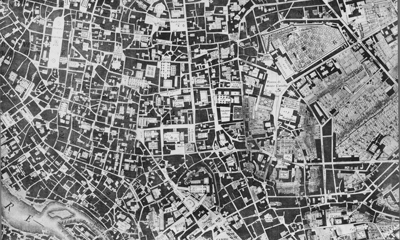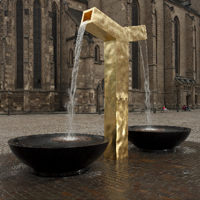You are in: Home page > Magazine Archive > Learning from Archimedes

Ondřej Císler
Learning from Archimedes
Meditation on Hierarchy
Abstract:
The article brings up a thesis that European towns can be to great extent improved by local limited actions that help to change the whole direction of development. One house, one block or just repairing a mistake in former structure are the key tasks of our era. It requires careful observation of Context, Hierarchy of the given structure and analysis of its Layering. An extreme example of such surgical touch to the city tissue is presented – Three Fountains for Pilsen.
Give me afixed pointand I will move the world.
Archimedes
The complex and contagious reality of European towns can hardly be addressed by completely new, general and abstract concepts. It seems to me that although the new theories based on fluidity and volatility are very pleasing and respond to our longing for beauty and adventurous nature of our thinking, they do not conform to the fact that the basic principles of our behavior still remain the same. There has obviously been a significant change in the means of transport and communication, but we still eat, sleep, work, socialize and entertain ourselves in a very similar way as we did centuries ago. We also perceive our built environments in rather conservative way, as influential images that form crucial parts of our inner identities, even though much of this perception is neither conscious, nor articulated. Architecture is still simply bound to this situation, and I consider this not as a restraint blocking the inevitable progress, but rather a great challenge and a way to proceed.
We have inherited results of long gradual development of our habitats that lasted for ages. As Claude Levi-Strauss proves in his famous book Tristes Tropiques, there has always been a strong aim for sustainability and firmness of the dwelling network in Europe, compared for example to a changeable character of later American settlements, typically built on orthogonal patterns from light balloon frame constructions only to be abandoned shortly after or completely replaced by new, similarly changeable structures (Levi Strauss, 1955).
We Europeans simply do not have enough inclination (and maybe scale, space or wealth) to repair former mistakes by moving to another locations or rebuilding the whole quarters from scratch few times a century. Our whole continent has been mapped, formed, built and rebuilt again so many times that we usually even do not have any idea what we are stepping on or passing by... The sunk stores of our cities, the networks of sacred places (maybe unattended, bud hardly imaginable to be erased), the paths, hedges, walls, gardens and parks, squares, houses, bridges ...
So it is probably the Layering that is one of the most important characteristics of European City Development. Layering, that at the end creates an intricate Context, as a higher level of social structure organization – is to me as an architect still probably the most important one. As if significant architecture always implemented some sort of refined language that deals with Context, be it sophisticated cultural constructions of Rem Koolhaas (Koolhaas et Al. 1998) or pictorial visions of Analoge Architektur drawn by Miroslav Šik (Sik, et Al. 1991).
We observe some signs of deterioration of original city structures – from the fading of the importance of acropolis, devitalization of town centers (Khan, 1957) and their turning into mere tourist attractions, then to the dissolution of the original functional grid, to the dilution of the vital population densities and abandonment of clear town boundaries. This comes hand in hand with excessive urban sprawl in all its variations, with implication to the destruction of surrounding cultural landscapes, where the society can only gain its vital power. (I do not want to judge the society and its life herein). One of the reasons this happens clearly is that we put aside the observation of natural sense of hierarchy of the city structure, its topographical and functional behavior.
The hierarchy seems to prevail in the organization of nature and the structure of our thoughts. Why should we not rebuild it in housing structures? For sure, this doesn't mean there is extra need for either uniformity or violent sovereignty of any particular concept. On contrary, this observation is an inevitable need and at the end it gives us freedom, this being an effective working method - like the original idea of Archimedes. Hitting directly what is important on different levels can bring much more effect than shooting all over in coverage fire, and it is also a source of architects critical thinking and concentration. We do not need to change the whole cities, but as in acupuncture, we can only change the crucial points as architects and the rest will move in the right way itself.
The majority of the houses being built today are not done by architects and usually do not carry any additional quality except for the vegetative one. The character and composition of many contexts is largely random. As opposed to that, the built-up places in the original habitats were definitely chosen with great care and sense for morphology and properties of the given landscape – like the one of the herds of animals that are intuitively able to choose the fittest place for them to rest in an open landscape. The best plots of the European land have been already built-up. Sometimes the houses are not fit anymore and sometimes time has revealed former mistakes and lack of good sense. So I think the key method in getting rid of the previously mentioned problems of deterioration is in careful replacement and modification of existing, wrongly done houses. It lies in the confirmation of hierarchy by putting the creative energy and maximum quality into the local centers according to the given scale – be it on larger scale of the metropolis or smaller scale of the periphery.
We must always revive where the Center is, where the Sub-centers of the Periphery are and where the Town ends. I sometimes doubt that contemporary urban design regards this properly. But the polarity of establishing the center, its borders and the gates to cross them was the key phenomenon of original Town establishment rituals on the European continent. This is not to be changed by any means. And it is the way I understand the question we have been asked to try to contemplate during the ongoing Festival.
In accord with Archimedes I believe that a point can help to spin the whole space at given level of its structure. I tried to implement this idea few times accordingly to given conditions. A House that centers the square, a local peak of an institution in the architectural structure, a bypass of a footbridge that enlivens the whole district of the city, few blocks that revive the original urbanization, a new house that repeats the original footprint and volumetric memory of the previous one.
To give a small example of this thesis projected in the real world and its conditions, I would like to present my first major realization from the year 2010. It is a project of Three Fountains for the Republic Square in Pilsen, the huge medieval public space (180x140 m) that was established on strictly orthogonal foundation with a huge cathedral in its northern part. The scale of the square combined with the highest cathedral spire in Central Europe is really monumental, royal, and it exceeds the scale of the surrounding houses. The space was too big to make people feel comfortable. The trick of the project, situated close to the locations of the non preserved original ones was to add one certain level of scale, which formed a transition between the scale of human and the surrounding city houses. To hail this royal atmosphere, we used huge spouts in forms of abstract signs that freely interpret the Coat of Arms of Pilsen, cast in gilded bronze. The bowls were cut from black Chinese granite - the materials are a reference to materials used on the Plague Pillar in the fourth corner of the square. The basic form of the fountains – spout and a bowl also refer to the traditional appearance of a fountain. The realization brought up a lot of rumor and served to enliven the public discussion about the topic of Architecture in the town, that will become European Capital of Culture in 2015. It also seems that this realization helped Pilsen to win the competition for this prestigious title, as the jury was very impressed by their brand new appearance.
I do not aim for great concepts that would revolutionize the whole era. There is no need for it. And anyway – at least there is a solace - all Cities have been already built by Italo Calvino. I believe that the combination of different yet similar qualities of individual projects together – the Ensemble of the Analogists maybe - forms the distinct beauty that our most graceful Towns are famous for. Let us try to expand this beauty.
Bibliography
Calvino, I., (1972) Cittŕ invisibili, Torino, Einaudi
Levi-Strauss, C., (1966) Tristi tropici, Torino, Einaudi, 2008
Kahn, L.I., (1957) Ordine dello spazio e architettura, in Architettura č, Milano, Electa, 2002
Koolhaas, Rem et. Al., (1995) Bigness ovvero il problema della Grande Dimensione in S,M,L,XL, New York, The Monicelli Press, 1998
Šik, Miroslav et Al., (1991) Analoge Architektur: Analogická architektura, exhibition catalogue, Jaroslav Fragner Gallery, Praha 1991
Calvino,I., (1972) Neviditelná města, Praha: Odeon
Levi-Strauss, C., (1966) Smutné tropy, Praha: Odeon
Kahn, L.I., (1957) Spaces Order and Architecture in: Ticho a sveˇtlo, Praha, Arbor Vitae, 1999
Koolhaas, Rem et. Al. (1995): "Bigness or the problem of Large", in S,M,L,XL, New York: The Monacelli Press
Šik, Miroslav et Al. (1991) Analoge Architektur: Analogická architektura, exhibition catalogue Jaroslav Fragner Gallery, Praha: Obec architektů














